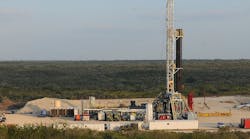Joining the ranks of industry players in developing gas-to-liquids (GTL) technologies, Conoco Inc., Houston, intends to inject a little bit of reality in the GTL picture (OGJ, July 10, 2000, Newsletter, p. 7).
Several players in the GTL arena are proposing plants too small to be profitable, said the company. Small plants will not be able to compete against the economies of scale that larger plants will use to their advantage in future GTL applications.
"We're afraid if we don't inject some reality into the process," said Paul J. Grimmer, manager of Conoco's natural gas refining group, during a media visit to the company's Ponca City, Okla., center, "GTL will lose credibility as a viable technology."
It's all about economies of scale, he said. The GTL plants are costly and complex. Economies of scale, according to Conoco, require a minimum plant capacity of 60,000 b/d, processed from 500 MMcfd of natural gas. For a 20-year life, profitable GTL projects require fields at least 4 tcf in size.
The firm revealed this past February that it is developing its own GTL process, when it announced the award of a contract to Howe-Baker Engineers Inc., Tyler, Tex., to design and construct a pilot plant. Since 1997, the GTL division within Conoco was a "skunkworks" operation: Very few people, even within the company, knew that Conoco was inventing its own GTL technology.
Today, Conoco is talking about its GTL processes because it wants to be a recognized player in the industry. The company itself has no large stranded gas reserves to accompany its future GTL plants and will depend on partnerships with outside companies or countries for gas supply. It expects to begin talks with public and national oil companies with large gas reserves within the next year.
Conoco has already begun discussions with other oil and gas companies about building GTL plants when the technology is ready.
Market, costs
The GTL process is often associated with clean fuels because the process makes diesel, naphtha, and wax products that are practically free of sulfur. It is broken into three main processes: synthetic gas (syngas; carbon monoxide and hydrogen) production, Fischer Tropsch (F-T) synthesis, and product work up.
The sensitivity of the syngas and F-T catalysts to sulfur requires that gas-processing plants upstream of the syngas reformers treat the gas to remove almost all the sulfur.
Diesel fuel from the F-T process has a sulfur content of less than1 ppm(wt), an aromatics content of less than 1 vol %, and a cetane index greater than 70.
Most US diesel fuel today contains 350 ppm(wt) of sulfur, 35 vol % aromatics, and a 45 cetane index. In May, the EPA proposed clean diesel sulfur contents of no more than 15 ppm (wt) by 2007.
The naphtha from the F-T process is also low in sulfur and contains a high proportion of paraffinic material. Although the F-T naphtha is not a very good gasoline component, its paraffin content makes it an excellent petrochemical feedstock.
Synthetic waxes from the process are priced significantly higher than petroleum waxes and are used in specialty applications. Conoco anticipates that the high margins for waxes will disappear with more GTL plants operating and thus views the wax market as small and only practical depending on local conditions.
The company is not targeting clean fuels, however, said Grimmer. It is targeting the commercialization of large fields of stranded gas, ones with no current method of transportation to markets or no evident value. These large reserves are located in the Former Soviet Union, the Middle East, Africa, Latin America, the Far East, and Alaska.
"We're comfortable that there are a lot of opportunities. We're comfortable that there's a market for our products," said Grimmer.
The question of viability for GTL is not market and technology, however, but costs.
The economics for a viable plant depend on the price of oil and gas as well as the capital, operating, and maintenance costs of the plant. Like Sasol Ltd., Johannesburg, Conoco is not relying on the $7-8 product premium others have suggested to increase the profitability of the technology. It is assuming a long-term oil price of $17/bbl to develop an economically viable process.
The price of oil is a big factor in the development of GTL. "If we could guarantee prices," said Grimmer, "you'd see a whole bunch of these [GTL plants] being built. You need those prices."
Low natural gas prices must also prevail. Even at 50¢/MMbtu, said Conoco, the gas cost can represent 25% of the cost to produce F-T liquids.
Realizing that the history of commodity prices is a tale of fluctuations, however, Conoco is working to manage the part of the profit equation over which it has control, that is, lowering the costs of the syngas and increasing efficiencies of its F-T process.
Recent advances of GTL technology have brought end-product costs to $30/bbl, nearly half the cost of the late 1970s. Prospects appear good for further cost reductions, perhaps to about $20/bbl, said Conoco, with significant improvements in reactor design and catalyst performance.
Conoco's ultimate goal is to design a GTL plant with capital costs at or less than $15,000/b/d, closer to the capital cost of a refinery. The goal for its first commercial unit is capital costs less than $20,000/b/d. Today, the company believes its technology allows it to build a plant for between $20,000/b/d and $25,000/b/d.
On a per-barrel basis, the two commercial plants today that use natural gas to produce liquids-one in Mossel Bay, South Africa, and the other in Bintulu, Malaysia-are three times as expensive as what Conoco is proposing for its commercial plant.
Although much of the focus is on optimizing catalyst and reactor synergies in the F-T process, reducing costs in syngas production, which accounts for more than 50% of capital costs, helps make the GTL technology viable.
Particularly, Conoco claims it can make 20% more product than some of its competitors with the same amount of gas. Instead of using 500 MMcfd to make a 50,000 b/d plant, Conoco says it can make a 60,000 b/d plant. Thus, it turns more carbon into product and reduces the amount of CO2 vented to the atmosphere per barrel of product. The more efficient use of its oxygen, in turn, reduces the load on the air-separation unit.
Reducing costs encompasses the whole process from making syngas to making the product, said Grimmer. "If you have a perfect F-T process, even if it were free, it can't go commercial. You need a whole new syngas technology and air separation. You've got to improve performance and drop costs completely throughout the system."
Future plans
Conoco has tested more than 4,000 catalyst formulations and 68 reactor configurations. Today, its laboratory in Ponca City, Okla., has 23 F-T reactors and 7 syngas reactors in operation.
Its 400-b/d pilot plant, to start up in mid-2002, will cost $40-50 million.
The syngas side will use a catalytic partial oxidation process to produce syngas. As the process is novel, Conoco is developing its own catalysts. The F-T process will use a slurry bubble column with cobalt catalyst.
Conoco will make the decision of the location of the pilot plant by the end of this year. It intends to build it near one of its US refineries where there would be synergies with utilities, taxes, and labor.
The small plant will give the company time to improve its processes to reduce capital costs even further, readying it for a scale up to a commercial 60,000 b/d GTL plant in 2007.
Grimmer said the company is about 4 years away from beginning engineering on a 60,000 b/d plant, which will cost about $1.2 billion, excluding gas processing costs. The commercial unit will likely be built on a coast, where the company will have access to cooling water and the ability to easily sell and transport the products.
The company's first commercial plant could include six slurry bubble columns, each about 25 ft in diameter and 100 ft tall, "three times bigger than anything we've ever built," said Grimmer.
On the other hand, Conoco's first commercial plant may not use slurry bubble columns at all. "This is one type of reactor being developed," Grimmer said, "but we have several others that look more promising than slurry bubble columns." Conoco expects greater than 90% conversion rates for its F-T commercial catalysts.
The oxygen plant will also be one of the largest ever made.
Tax structures and other costs of doing business will be determining factors in the location of the commercial plant.
It is unlikely that a GTL plant will be built in the US, said Grimmer. On the Alaskan North Slope, if gas prices hold at the $3-4/MMbtu range, a pipeline to the lower 48 states may become feasible, he predicted. Conoco is pursuing a wide range of opportunities in Russia, the Middle East, Venezuela, Nigeria, Algeria, Libya, and Qatar.

